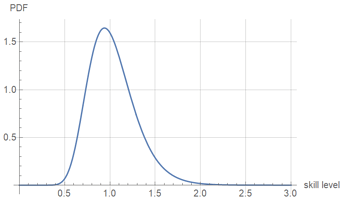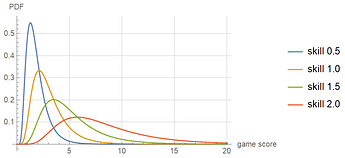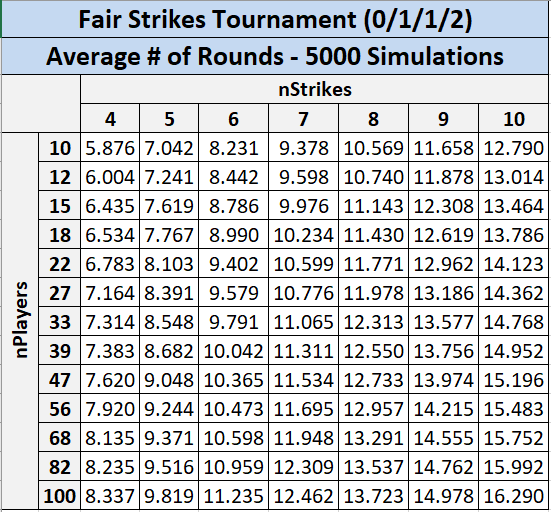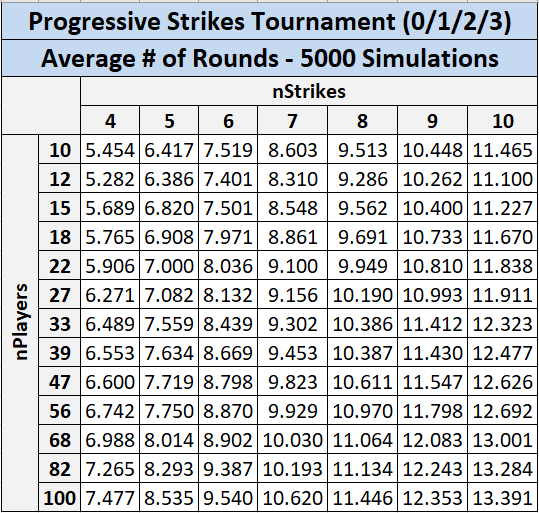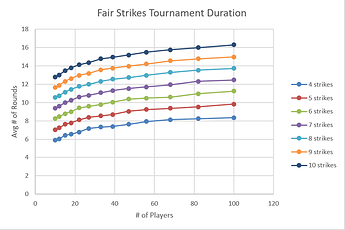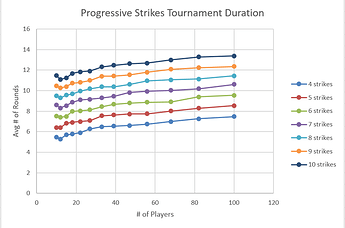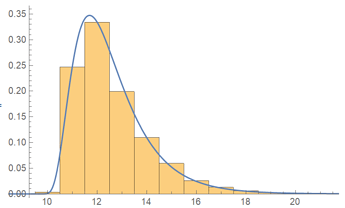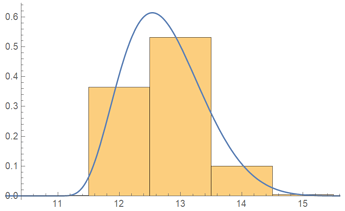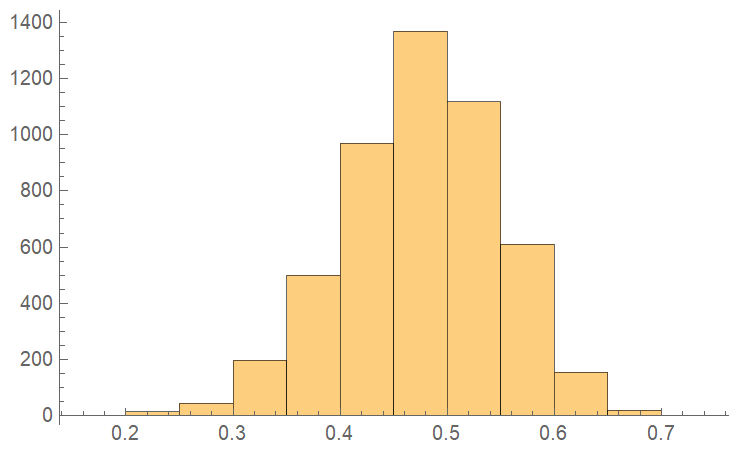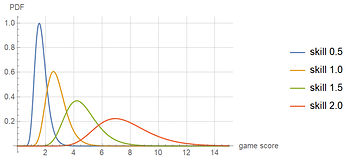The following information may be useful to those planning to run a tournament.
Introduction:
Strikes-based tournaments were simulated to determine the number of rounds required to finish a tournament. This was done using a Monte Carlo simulation method, meaning some simulation inputs were randomized for a large number of simulations, then statistics were calculated using the results. Some tournament inputs are within the power of the TD to control (number of entrants, number of strikes), while others are not (how well each player plays that day), hence the Monte Carlo approach.
Player Model:
Players are assigned a base skill level chosen from a log-normal distribution whose first parameter is 0 and whose second parameter is 0.25. There is nothing special about this distribution; it’s an arbitrary choice.
The distribution of base skill levels looks like this:
The majority of players have a skill level in-between 0.5 and 2.0, with 0.5 being a very poor player, and 2.0 being a highly-skilled player. The peak (or mode) of the distribution occurs at ~0.94, representing a player of moderate skill.
Game Score Model:
A player’s score on any particular game is modeled as a random variable chosen from another log-normal distribution whose first parameter is the player’s skill, and whose second parameter is 0.5. We want it to be possible for a good player to lose to a player of lower skill, but with diminishing probability as the skill levels grow further apart. The game score distribution for four players of different skill levels are shown below:
It is apparent that the 0.5-skill player’s game scores will have relatively little overlap with those of the 2.0-skill player, but the overlap is not zero - it’s not impossible for the low-skilled player to win, merely unlikely. To quantity how unlikely, consider the following pairings:
- 0.5 skill vs. 1.0 skill: Higher skill player wins 76% of the time
- 0.5 skill vs. 1.5 skill: Higher skill player wins 92% of the time
- 0.5 skill vs. 2.0 skill: Higher skill player wins 98.3% of the time
- 1.0 skill vs. 1.5 skill: Higher skill player wins 76% of the time
- 1.0 skill vs. 2.0 skill: Higher skill player wins 92% of the time
- 1.5 skill vs. 2.0 skill: Higher skill player wins 76% of the time
This seems reasonable for the results of a single game. The best players will almost (but not quite) certainly beat the worst players, but there’s a slim chance of an upset. This model does not need to be perfect to be useful.
Tournament Rules
Two types of strikes-based tournaments were analyzed: Fair Strikes and Progressive Strikes. After each game, the Fair Strikes system assigns strikes based on score ranking on that game, with 1st place receiving 0 strikes, 2nd & 3rd place each receiving 1 strike, and 4th place receiving 2 strikes. The full assignment is shown below:
- 4 players per game: 0/1/1/2
- 3 players per game: 0/1/2
- 2 players per game: 0/2
The Progressive Strikes system also assigns strikes based on score ranking on the game, but with each player receiving a number of strikes equal to the number of players that beat them on that game.
- 4 players per game: 0/1/2/3
- 3 players per game: 0/1/2
- 2 players per game: 0/1
In all simulations, the Swiss method is used to group players. After each round, the list of players still in the tournament is shuffled, then (stable-)sorted by number of strikes. Therefore, after Round 1, players with 0 strikes will tend to be grouped together, and players with 2 strikes will tend to be grouped together as well.
In all simulations, 4 players per game is the preferred arrangement. When the number of players still in the tournament is not divisible by 4, the groups are arranged to maximize the size of the smallest group. The partitioning is done such that the players with the fewest strikes end up in larger groups. Some examples:
- 17 players are partitioned into 4 and 4 and 3 and 3 and 3
- 16 players are partitioned into 4 and 4 and 4 and 4
- 6 players are partitioned into 3 and 3
- 5 players are partitioned into 3 and 2
Average Duration Statistics:
How long will the tournament last? In other words, how many rounds will be required for a winner to be selected? The answer depends on many things, including the number of entrants, the number of strikes required for a player to be eliminated, and the manner in which strikes are assigned.
In the following tables, each cell shows the average (mean) number of rounds required to conclude a tournament with a specific number of players (row labels) and a specific number of strikes (column labels). Due to limited computational power, only specific numbers of entrants were examined: 10, 12, 15, 18, 22, 27, 33, 39, 47, 56, 68, 82, and 100 players. This is sufficient to see the broad trends, but some details and squiggles in the curves are lost. Every number of strikes from 4 to 10 was simulated. Each combination of player count and number of strikes was given 5000 fully-simulated tournaments. The total is 910,000 tournaments simulated to generate the following statistics.
This same data is shown graphically below:
We can see that player count has a relatively weak effect on the duration of the tournament, while number of strikes must be chosen carefully, as it has a strong effect on duration.
Variance Deep Dive:
It’s also important to note that these are only average durations. Let’s now do a deep dive into a theoretical 47-player, 10-strike tournament to understand the variance.
If the tournament is run with Progressive Strikes rules, we obtain a distribution of durations:
Average duration = ~12.5694 rounds
- 10 rounds: 16 sims
- 11 rounds: 1234 sims
- 12 rounds: 1671 sims
- 13 rounds: 995 sims
- 14 rounds: 548 sims
- 15 rounds: 297 sims
- 16 rounds: 129 sims
- 17 rounds: 64 sims
- 18 rounds: 31 sims
- 19 rounds: 12 sims
- 20 rounds: 2 sims
- 21 rounds: 1 sims
The histogram for this data (and a Johnson distribution fit to the data) is shown below:
If everything lines up just right, the tournament could conclude in as few as 10 rounds, but is much more likely to take 11, 12, or 13 rounds, with 12 rounds being the most likely result. However, the distribution has a long right tail, due to the possibility of ending up with two dominant players, each of whom have few strikes. In this case, a large number of 1v1 matches (each assigning only a single strike) will be required to select a winner, potentially extending the tournament length significantly. If this seems likely, the TD might be compelled to call ‘sudden death’ once two players remain, doubling the number of assigned strikes to hasten the tournament’s conclusion, but this was not part of the simulation.
Compare this to a 47-person, 8-strikes tournament using the Fair Strikes scoring method, which has a similar mean duration. Again, 5000 tournaments were simulated, giving the following results:
Average duration = ~12.7424 rounds
- 11 rounds: 3 sims
- 12 rounds: 1820 sims
- 13 rounds: 2659 sims
- 14 rounds: 498 sims
- 15 rounds: 20 sims
The mean is very similar, but the scatter is greatly reduced. Since the rules dictate last place on a game always receives 2 strikes, the right tail of the distribution is greatly truncated. The tournament will conclude in anywhere between 11 and 15 rounds, with 13 being the most likely and ~12.7424 being the mean.
Conclusions:
Progressive Strikes is the most ‘fair’, since it preserves the desirable attribute of monotonic scoring - beating another player is always better than losing to them. However, it has a somewhat high variance which introduces the possibility of a tournament running over its allotted time, or at least concluding in a somewhat uncertain amount of time.
Fair Strikes sacrifices monotonic scoring, but gives the TD greater assurance over the tournament length, and may be a better choice if time is a constraint.
